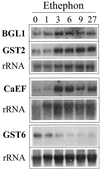Induced plant defense responses against chewing insects. Ethylene signaling reduces resistance of Arabidopsis against Egyptian cotton worm but not diamondback moth
- PMID: 11080278
- PMCID: PMC59200
- DOI: 10.1104/pp.124.3.1007
Induced plant defense responses against chewing insects. Ethylene signaling reduces resistance of Arabidopsis against Egyptian cotton worm but not diamondback moth
Erratum in
- Plant Physiol 2001 Apr;125(4):2203
Abstract
The induction of plant defenses by insect feeding is regulated via multiple signaling cascades. One of them, ethylene signaling, increases susceptibility of Arabidopsis to the generalist herbivore Egyptian cotton worm (Spodoptera littoralis; Lepidoptera: Noctuidae). The hookless1 mutation, which affects a downstream component of ethylene signaling, conferred resistance to Egyptian cotton worm as compared with wild-type plants. Likewise, ein2, a mutant in a central component of the ethylene signaling pathway, caused enhanced resistance to Egyptian cotton worm that was similar in magnitude to hookless1. Moreover, pretreatment of plants with ethephon (2-chloroethanephosphonic acid), a chemical that releases ethylene, elevated plant susceptibility to Egyptian cotton worm. By contrast, these mutations in the ethylene-signaling pathway had no detectable effects on diamondback moth (Plutella xylostella) feeding. It is surprising that this is not due to nonactivation of defense signaling, because diamondback moth does induce genes that relate to wound-response pathways. Of these wound-related genes, jasmonic acid regulates a novel beta-glucosidase 1 (BGL1), whereas ethylene controls a putative calcium-binding elongation factor hand protein. These results suggest that a specialist insect herbivore triggers general wound-response pathways in Arabidopsis but, unlike a generalist herbivore, does not react to ethylene-mediated physiological changes.
Figures









References
-
- Agrawal AA. Induced responses to herbivory and increased plant performance. Science. 1998;279:1201–1202. - PubMed
-
- Agrawal AA. Induced responses to herbivory in wild radish: effects on several herbivores and plant fitness. Ecology. 1999;80:1713–1723.
-
- Alborn HT, Turlings TCJ, Jones TH, Stenhagen G, Loughrin JH, Tumlinson JH. An elicitor of plant volatiles from beet armyworm oral secretion. Science. 1997;276:945–949.
-
- Alonso JM, Hirayama T, Roman G, Nourizadeh S, Ecker JR. EIN2, a bifunctional transducer of ethylene and stress responses in Arabidopsis. Science. 1999;284:2148–2152. - PubMed
-
- Baldwin IT, Preston CA. The eco-physiological complexity of plant responses to insect herbivores. Planta. 1999;208:137–145.
Publication types
MeSH terms
Substances
Associated data
- Actions
LinkOut - more resources
Full Text Sources
Other Literature Sources
Molecular Biology Databases

